Introduction
Assigned image: Bustle
Creator: Pierre-Auguste Renoir
Title: Portrait of Charles Le Coeur
Date: 1874
Material: oil on canvas
Measurements: 42 x 30 cm
Description: Inscription: signed on the lower left: A. Renoir; inscribed on the upper right: ô GalantJard
Repository: Musée d’Orsay
Collection: Art, Archaeology and Architecture (Erich Lessing Culture and Fine Arts Archives)
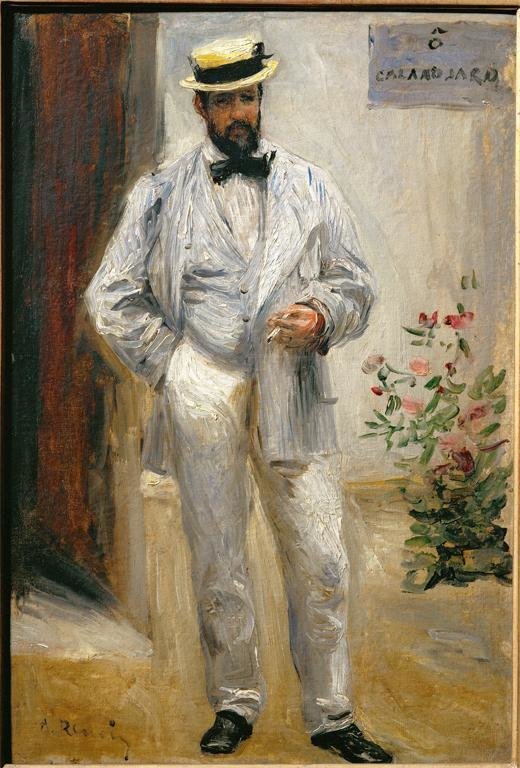
The purpose of this assignment is to produce a paper in the style of a scholarly journal of costume history. The assignment focuses on the Bustle costume with specific reference to the Portrait of Charles Le Coeur (1874) painted by Pierre-Auguste Renoir. It uses OREO (opinion, reason, example and opinion) Method to complete the analysis processes.
Pierre-Auguste Renoir painted the Portrait of Charles le Coeur in 1874. This portrait reflects the work of art of oil on canvas. The portrait was rated as the second most prestigious because of the way it captured visual elements of the human subject. This was the period of Impressionism (1860s – 1892) and Bustle costumes.
There were notable changes in men’s fashion from the Crinoline to the Bustle. Bustle costumes were characterized by a wide variety of “coats and hats, knee-breeches, and men were less flamboyant with whiskers and had closer-cropped hair”. Previously, breeches were associated with royalty but were now found among the middle class.
These changes in fashion reflected changes associated with free-and-easy world in which men were careful and restrained their grooming to meet the standards of good dressing codes. Artists struggled to achieve the exact resemblance of the subject.
However, the portrait viewers’ opinions and recognition of the real subject remained critical areas of importance. In some cases, it was normal for a painter to change the appearance of the subject to accentuate or reduce the subject’s features and characteristics such physical, social and psychological ones.
Traditionally, expensive costumes and portraits were generally associated with royal class, rich and powerful individuals in society. After several centuries, however, the middle class families also started to “commission artists for their portraits, families and colleagues”.
Opinion
The Bustle costumes were associated with extremely wealthy and fashionable people of during the period of Impressionism. The costume of Charles le Coeur reflects the Bustle period when expensive costumes were no longer associated with aristocracy.
Charles le Coeur is wearing a shirt, a trouser, a bowtie, a waistcoat, a topcoat and flat pair of shoe with ties and he is wearing short with facial hair and a boater. He has a cigar in one hand while another hand is in the pocket.
The straw boater or top hat was notable during the Bustle costume period and the Portrait of Charles le Coeur clearly captured this accessory. It was popular for sporting and summer activities to show a sign of ‘free-and-easy world as opposed to the previous period of counting-house.
The costume of the portrait reflects this period of Bustle costumes. Men’s fashion had changed. These garments were no longer associated with the aristocracy but the middle class. Tailors had significant influences over men’s fashion.
During the period of Bustle costumes or the impressionism, the avant-gardes sought to introduce new forms of costumes to separate themselves from the old school. As a result, the costumes of the portraits of were innovative, new with contemporary styles by focusing purely on the costumes and their accessories rather than the subject.
In such cases, portraits could alter the “subject’s physical, social or psychology traits”. The period of Bustle costume established Paris as a major fashion spot of the world. There was originality, vibrancy and attractiveness notable in the latest fashion trends. As a result, these artists found opportunities to express and write about contemporary fashion, its richness and elements of life at the time.
These artists used portraits to reflect modernity and fashion. This was the era of Napoleon II and Haussmann in which an incredible rise of the middle class and the developments noted in department outlets took place. Industrial designers also had opportunities to offer their designs developed from reputable lithographs. On the other hand, tailors and dressmakers had greater opportunities for custom fitted clothes, and this period marked their heydays.
Men and women’s attires became the point of reference and perhaps the ultimate show of stylishness. The Bustle costumes show that by 1860s, fashion had evolved significantly. Men and women dressed in trendy garments to show patterns that could be easily obtained in fashion magazines and journals. Moreover, any tailors or dressmakers could easily do these fashions and designs.
Some dressmakers of some fashionable dresses remained unknown (the case of Madame Bartholomé’s stylish summer dress), but these dresses had elements of stylish structure combined with well controlled pleating and visible draping. The period of Bustle costume was also marked with changes in men’s fashion as the costume of the Portrait of Charles le Coeur shows. This was rather formal and staid, particularly toward the end of the 19th century.
While women changed their attires based on the occasion or time of the day, man generally considered evening dress or daytime wear due to lack of a wide range of choices. Charles le Coeur is in evening dress. From the costume, one can observe that men did not have many options and freedom of colors and Robinson noted that “Masculine colors continued to monochromatic and drab but they made up for that in patterns of plaid, checks or sprigs”.
Other accessories could depict some colors for men. The attire is simple. The details are simple and not extravagance (Portrait of Charles Le Coeur). This is opposed to women’s fashion, which took the opposite direction (Family Reunion, 1867). The costume of the Portrait of Charles le Coeur clearly captures this simplicity and a lack of extravagance.
To make them more distinct, the middle class chose to concentrate on cropped hair and innovative use of cigar at the hand. The artist introduced a flower prop and other accessories in the background. There was a decoration on the wall and the background door was left ajar.
Renoir expressed an ‘arrogantly relaxed’ Charles le Coeur in his frock coat, a cigar in one hand, another hand in the pocket, with a top hat and a bow tie to add depth to the costume of the portrait.
Reasons (Social setting and Context)
The costume of the portrait worn by Charles le Coeur is exceptional style of the Bustle period. This period marked the rise of the wealthy, middle class in Europe. The garments are expensive, extremely stylized and meant for day or evening wear.
It was popular for sporting and summer activities to show a sign of ‘free-and-easy world as opposed to the previous period of counting-house. They were not meant for any form of labor. The middle class in Paris established Paris as a fashion city.
Many costumes of portraits associated with this period showed significant emphasis on accouterments. In fact, they could be found on popular prints, fashion magazines, photographs among others to reflect the deep relations between art and fashion. There were increasing numbers of department stores in Paris. In addition, tailors were readily available for ready-made cloths and fashion prints increased awareness.
Contemporary artists, mainly the avant-gardes, such as Monet, Degas, Gustave, Renoir and Manet among others took this opportunity to explore fashion at this period. The costume of the portrait is extremely bright achieved by optical effects of light on the subject to communicate changes in time, weather and other transformations on in daily life. Renoir clearly depicts the use of bright colors in the costume of the Portrait of Charles le Coeur.
Impressionists were widely recognized for their effective “brushwork and they lightened their portrait costumes to introduce pure, bright colors”. This is the case of the costume of the Portrait of Charles le Coeur because the costume is excessively bright. The artists deviated from the normal traditional linear approach and did not embrace the clarity of form in the works.
Based on this observation, several art critics claimed that Impressionists’ art works were substandard in quality and appeared incomplete. However, the Impressionists wanted to capture the ongoing changes in Paris after the renovation. There were new developments such new railway stations, large open space, large deluxe houses and tree-lined large streets (Street in Paris; Rainy Weather).
Impressionists were concerned with the everyday scenes of public leisure. Specifically, they wanted to depict strolling couples, scenes at public places, cafés and cabarets. In these works, they strived to portray the new form of alienation experienced by occupants of the emerging cities.
The costume of the Portrait of Charles le Coeur shows painting techniques that consisted of short, incomplete brushstrokes, which hardly depicted any forms, pure unblended paints and a strong focus on impacts of light. These artists often preferred “color highlights and shadows on the canvas rather than using neutral white, gray or black colors”.
Their loose brush strokes created effects of artless and effortlessness that concealed the often cautiously constructed portraits as depicted in the costume of the Portrait of Charles le Coeur. Previously, many artists preferred to use “the thick golden varnish to reduce the brightness of their art works”.
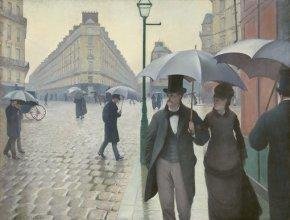
Moreover, artists were also vivid. At this period, there was a notable development in the synthetic materials and colors for garments. This offered vibrant shades of a wide range of colors that artists had never used before in their works.
For instance, Luncheon of the Boating Party, 1881 depicted a scene of a daily family life with bright, vivid colors. Captured in radically cropped, fashionable top hats with family members displaying elements of modernity in their form, their accessories and materials applied in the portrait. The costume of the Portrait of Charles le Coeur reflects modernity.
This was a new way of viewing the world, understanding the suburbs, city dwellers and life at the countryside. As a result, painters acted as mirrors of society and modernization and thus, they portrayed their diverse views through costumes of portraits. For these artists, modernity, based on their own understanding, became the dominant subject matter.
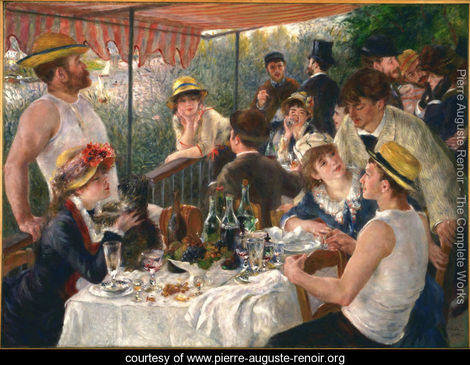
Modernity displaced the previously portrayed biblical scenes, mythology and historical phenomena that persisted in the previous century paintings. To some extent, the elements of streets, floorshow, seaside and homes became the modern methods of depicting history.
Examples (Comparisons)
The costume of the Portrait of Charles le Coeur appears to be extremely similar or share similar accouterments to the contemporary portraits of Bazille’s Family Reunion, 1867, Luncheon of the Boating Party, 1881, Portraits at the Stock Exchange, and Street in Paris; Rainy Weather, 1877.
The top hat is a common accessory in all costume portraits. Bowties, flat shoes, frock coats and simple color costumes are seen in all costumes of the portraits. These accessories and garments reflect the lifestyle of exceptionally urban dwellers during the Bustle period.
Costumes of portraits aimed to capture elements of social life, modern taste and characters of their subjects in a vivid manner. Many fashion experts recommended simple white color for summertime occasions. These colors were regarded as informal and modern.
The role of men in fashion and art during this period was clear in the mind of artists. Both costumes show that men wore top hats, vested suits with cigar or canes in their hands. This was a simple and stiff fashion statement relative to Bustle costumes of women during this period. Top hats in both portraits reflected social status, which could easily be lost because of uncertainties in the markets due to an international failure of the bank in 1873.
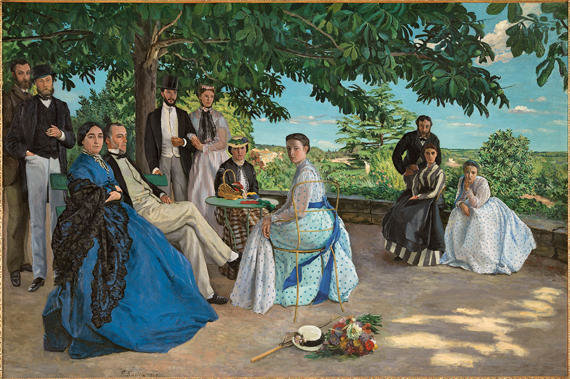
Black became less favored color as the costume of the Portrait of Charles le Coeur shows. There were new materials developed from aniline dyes. The chemical industries embarked on providing vivid colors, especially mauve. Nevertheless, black did not completely disappear from men’s fashion.
It was reserved for professionals such as bankers and executives for their frock coats (see figure 5). From different portraits presented in this analysis, one can observe that men had few choices for colorful hues relative to the previous century. Suits were generally of different colors based on tastes and styles of their owners. Top hats, however, reinforced the class of the subject (see all costumes of the portraits).
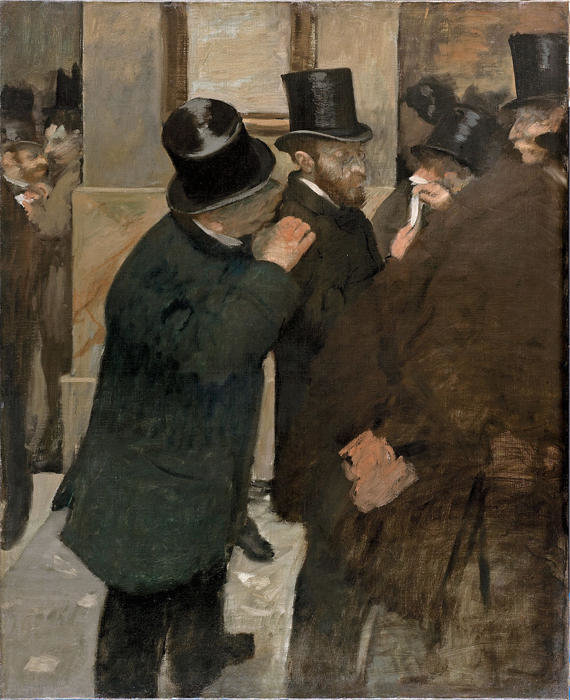
Opinion
Bustle costumes focused on elements of modern life, particularly notable changes in Paris. Costumes that were previously found among the royal class were now available to the bourgeoisie as their wealth grew. The middle class invented certain desirable activities such as walking, boating, dinners, floorshow among others.
As a result, there was a need for outdoor dress to complete the occasion. Costumes of portraits reflected elements of modern life. Men used costumes and style to communicate their tastes, trend, youth, sophistication and participation in social life and public activities.
These elements became the central elements of concerns for Impressionists who focused on modernity in their art works. Street portraits, for instance, depicted the elements of urban fashion, open streets, social occasions and leisure walking among others.
One can observe that Bustle costume period went far beyond fashion as a social indicator. Some of the revolutionary and remarkable costumes of portraits analyzed in this case originated from the artists’ search for perfect expression that could reflect contemporary life during the time of a significant urban development in Europe, which did not just create new forms of portraits, but also contemporary fashion and changes in lifestyle.
In this period, one can see that fashion for both men and women had a significant place in society. Bustle costume period was difficult to understand because of its several facets and different participants who experimented with a wide variety of paints from chemical industries.
Certainly, the period of Bustle costume move quickly as the light elements it created on subjects. Even so, Bustle costumes left critical mark in the fashion industry by embracing technology and modernity that became the springboard for later innovative artists. Bustle costume period was famed for its light and reflection, short brushstrokes, sharp, bright colors, dashes, fast painted canvas and modern life as the main subject matters.
Bibliography
Brettell, Richard R. Impressionism: Painting Quickly in France, 1860-1890. New Haven: Yale University Press, 2000.
Herbert, Robert. Impressionism: Art, Leisure, and Parisian Society. New Haven: Yale University Press, 1988.
Robinson, Scott R. “Bustle Costume.” Central Washington University. 2010.
Thomson, Belinda. Impressionism: Origins, Practice and Reception. London: Thames and Hudson, 2000.
Tinterow, Gary, and Henri Loyrette. Origins of Impressionism. New York: Metropolitan Museum of Art, 1994.
Voves, Ed. “Impressionism, Fashion, and Modernity: Metropolitan Museum of Art, New York.” California Literary Review. 2013.